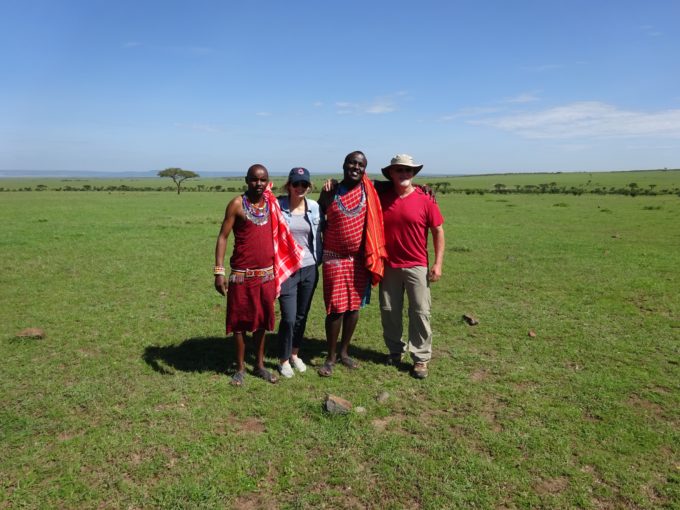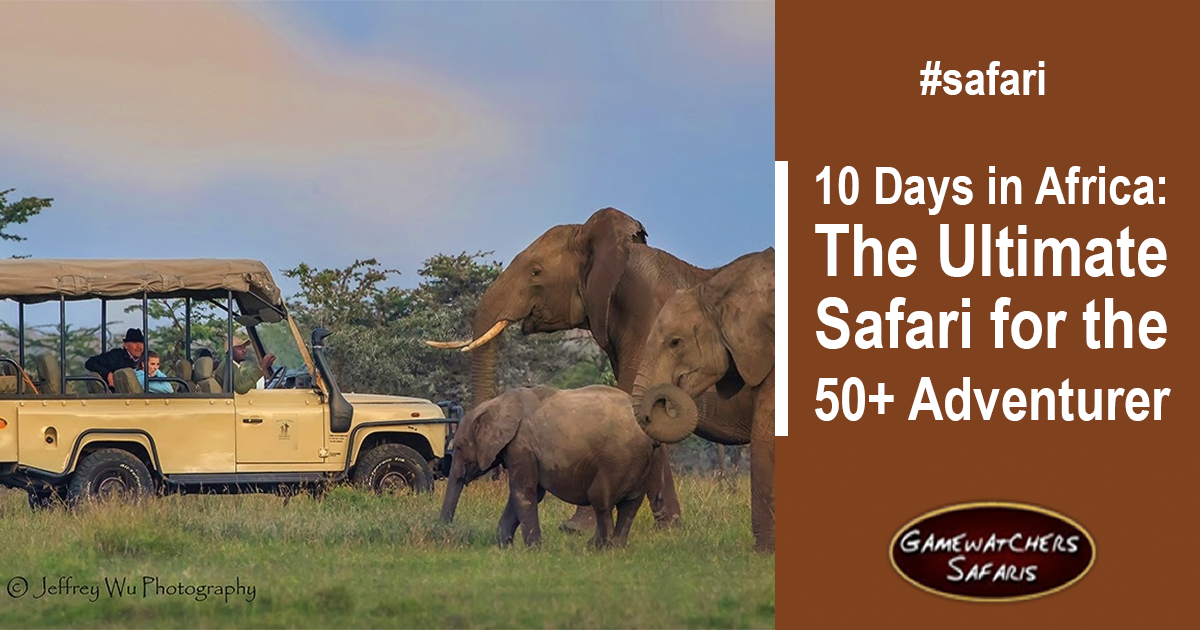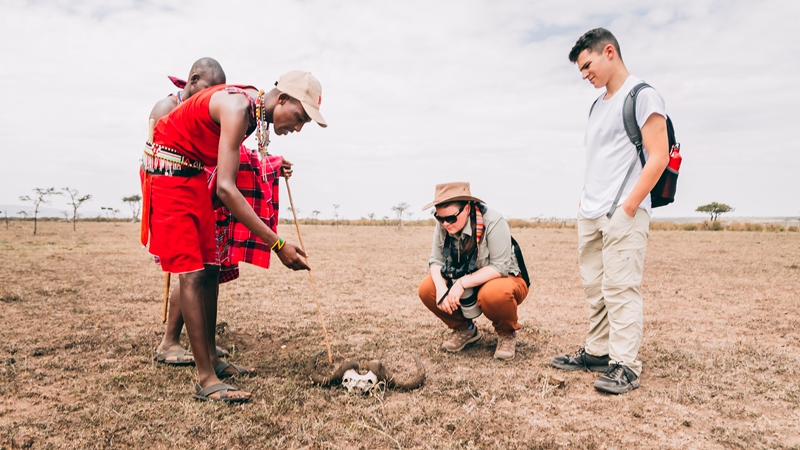
Have you ever imagined taking a slow-paced adventurous tour inside Africa’s wilderness on foot? Walking safaris are exactly that. Also known as bushwalks, walking safaris are completely different from game drives as they awaken all your senses allowing you to notice smells, sounds, and even colors of the wilderness.
Walking is prohibited in most of Kenya’s National Parks and reserves, however, in conservancies, it is an exciting option. One of the activities that we offer guests at Porini Camps is guided walking safaris. To ensure their safety, we ensure guests are accompanied by experienced and professional Maasai safari guides and armed rangers.
Exploring the bush on foot brings you really close to nature as you learn about vegetation and animal behavior in detail.
“You get to learn about the trees, their traditional uses by the community, you get to see and sometimes even try wild berries, you get to see wild carrots, those that you can use as food, and you also could get to learn about some medicinal plants as well as animal footprints, animal “poo”, you will be able to understand more through the little things that you don’t usually get to see when you are on a drive,” says Jimmy Lemara, a professional guide, and manager at Porini Mara Camp.
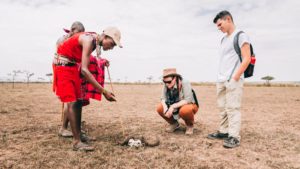
Before embarking on the walk, all participants are briefed on the dos and don’ts of the adventure. First, when walking through the bushes, all guests are required to walk in a single file. Second, while walking on the open plains, guests are encouraged to walk together as a group. This ensures the animals remain at ease. Thirdly, guests are required to be as attentive as possible and listen to their guide throughout the walk.
During a stay at Porini Mara Camp, I had an opportunity to join Jimmy Lemara, a professional guide and manager at the camp together with two other guests who wanted to experience the magic of the bush on a walk. We left the camp at around 4.30 pm when the sun was not too hot carrying our Porini branded metallic water bottles.
A few metres from the camp we came across the skull of an elephant. Jimmy and the other Maasai guides examined the skull and established it belonged to an old female elephant.
“This was a female and it had the second last set of teeth, so this was the last set coming out. Do you see this? The teeth are broken at this point. So this set is almost finished and the other set is pushing from the back here. Elephants get six sets of teeth and at the end of this one, there will be no more, an elephant dies of starvation because they cannot chew so they can’t eat,” Jimmy explains while pointing to its teeth with his rungu (Swahili word for a wooden club popular among Maasai’s as an emblem of warrior status).
Jimmy further explains that the elephant died of stomach complications as reported by the veterinary.
Next, we come across the Orange-Leaf Croton (Croton dichotomous), a tree with a natural insect repellent that is used by the local Maasai people to sweep their houses to keep flies away. Cats such as lions, leopards, and cheetahs also take shade under this tree to avoid insect bites and fly disturbance. It is the fly season in the Mara, so Jimmy tells us we can pluck some branches with leaflets and rub them on our clothes and skin to keep the flies at bay. Surprisingly, it does work.
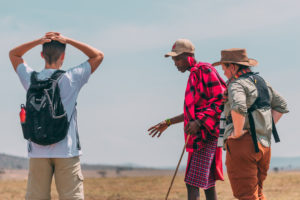
As we continue walking, we spot another interesting-looking acacia tree. The tree has straight spines and large bulbous bases. Jimmy says it is called the Whistling Thorn (Vachellia drepanolobium).
“It is called a Whistling thorn because ants make holes in the bulbous bases and then when the wind blows, it makes a whistling sound as it blows through the holes. If you look at it a little closer, there are holes that ants use to go into the plant. Oh! Look… I just touched it and the ants are coming out. So they have a relationship with the plant. The plant provides them with food and they in return, protect the plant from the browsers. So, if a giraffe tries to browse on the soft parts of the plant, then all these ants will come out and get to the tongue,” says Jimmy.
When we reached the base of the hill, we came across a Greater honeyguide (Scientific name Indicator indicator). The Maasai warriors whistled to communicate with the bird which then made a distinctive call it led us to a tree that had a wild African bee honeycomb. Historically, the bird relies on man or on honey badgers to get wild honey out of a hole in a tree. In a very random and unique experience, we watched the warriors cover themselves with their Maasai shukas to protect themselves from the sting of the bees, light a fire right next to a tree to smoke the bees out, and harvest the honey right in the middle of nowhere. They made sure they left some for the honeyguide. Watch the video of the wild honey harvesting experience here: https://youtu.be/NIe0nU-5D34
We reached the top of the hill at sunset, around 6 pm, where we enjoyed a peaceful sundowner with a magnificent view of the conservancy as we enjoyed the taste of freshly harvested wild honey.
Watch: Ol Kinyei Conservancy Walking Safari With Jimmy Lemara – Maasai Mara
Jackson Liaram, a Porini Guide says that you can also expect to see medicinal plants used by local people for medicine, perfume, or decorations while on a bushwalk including Elephant pudding (Cissus rotundifolia), a succulent used to treat eye allergies and infection; Sandpaper bush(Cordia ovalis), an evergreen bush with rough leaves used to smoothen walking sticks and fingernails and Elephant pepper tree (Warbugia ugandensis), a tree with quinine. The Maasai used its bark and roots in a concoction that is used to treat malaria.
Guided safari walks are part of the package at Porini Camps. So next time you visit one of our camps, make sure you request a guided walk with Porini Maasai warriors for a chance to get engrossed in the wilderness and track the footprints of the big cats and their prey.
Check out our latest offers here: https://www.porini.com/special-offers/
on Tuesday 21st February 2023 at 12:08



